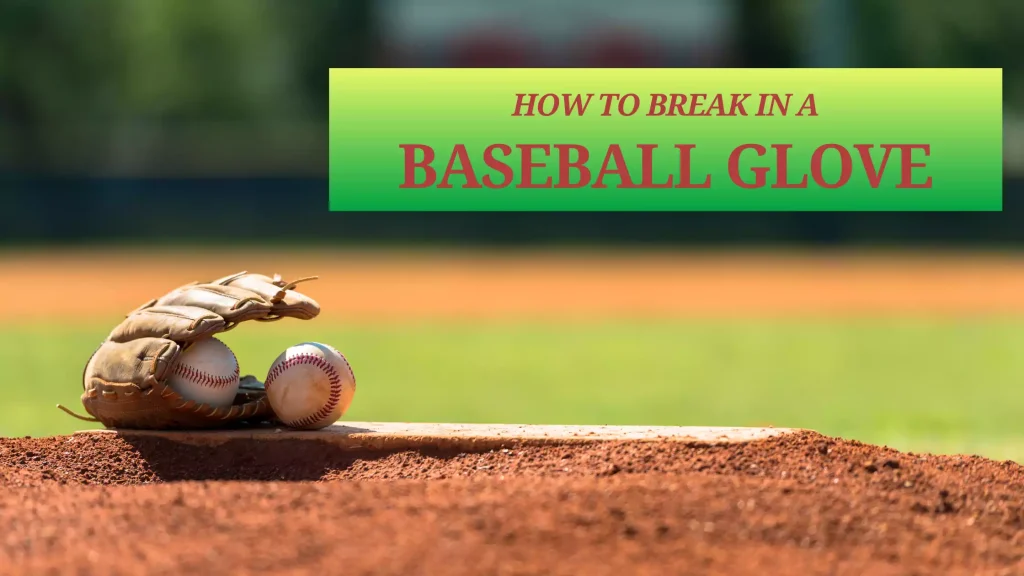Breaking in a baseball glove is necessary for any player who wants to perform at their best. A stiff, new glove can make catching tricky, but with suitable methods, you can soften the leather and shape the glove to fit your hand perfectly. Here’s a simple guide on how to break in your glove and get it ready for the game.
Overview
A high-quality baseball glove is essential for any player, whether you’re just starting or have years of experience. While synthetic gloves are often ready to use immediately, leather gloves need time and effort to break in properly. A well-broken glove fits comfortably and helps you easily catch the ball, making it feel like a natural extension of your hand.
However, there’s a lot of misleading information about how to break in a glove. Some methods can damage the glove and shorten its lifespan. This guide will show you the safest and most effective ways to break in your baseball glove correctly.
Why Do Baseball Gloves Need to Be Broken In?
Baseball gloves are made from high-quality leather, naturally stiff when new. This stiffness can make it difficult to close the glove and catch the ball. You soften the leather by breaking in the glove, making it easier to shape the glove to fit your hand and playing style.
As you break in the glove, the leather stretches and conforms to your hand, creating a custom fit that improves your performance on the field. A well-broken-in glove will have a perfectly formed pocket for catching the ball and will open and close effortlessly.
Step-by-Step Process to Break in a Baseball Glove
Step 1: Prepare the Glove with Warm Water
Start by warming up some water—not boiling, just warm enough to soften the leather. Pour the water over the palm area of the glove, making sure it doesn’t get into the finger stalls. This softens the leather, making it easier to stretch and shape.
Step 2: Stretch and Shape the Glove
Hold the glove slightly damp so the back of the fingers is facing you. Grab the thumb and pinky of the glove and gently stretch them back and forth. This helps soften the heel of the glove, which is usually the stiffest part. Be careful not to overstretch the fingers to keep the glove durable.
Step 3: Form the Pocket
To start shaping your glove pocket, use a glove mallet or even a baseball. Begin by gently pounding the center of the glove. The ball will land in the pocket, so it’s essential to shape it according to your position. Catchers and infielders prefer shallower pockets for quick ball transfers, while outfielders may opt for deeper pockets.
Step 4: Use a Mallet to Soften Key Areas
Close the glove and start pounding it with a mallet, focusing on the thumb and pinkie sides to create natural break points. This will make it easier to open and close the glove. You can also fold the web top into an ‘S’ shape and squeeze it to loosen the laces, allowing for better closure.
Step 5: Play Catch to Finalize the Break-In
The best way to break in your glove is to use it. Make it a habit to play catch regularly so the glove can naturally mold to your hand. This approach ensures a perfect fit and helps the glove last for many seasons.
Alternative Methods to Speed Up the Process
If you’re in a hurry, here are a few alternative methods to help break in your glove faster:
- Steaming: Many sporting goods stores offer glove steaming services. The steam softens the leather, but be cautious — it can weaken the leather fibers, which may reduce the glove’s durability over time.
- Glove Wrapping: After forming the pocket, place a baseball inside and wrap the glove tightly with rubber bands. Let it sit overnight. This method helps mold the glove while it’s not in use.
- Conditioners and Oils: Using manufacturer-approved oils and conditioners can soften the leather and protect it from cracking. Apply a small amount and rub it in with a clean cloth. Use products specifically designed for baseball gloves, as household items like Vaseline or shaving cream can damage the leather.
What to Avoid During the Break-In Process
While there are many effective methods for breaking in a glove, some techniques should be avoided:
- Please do not use excessive heat: Some people suggest microwaving or baking the glove to soften it. This is a bad idea because heat can dry out the leather, making it brittle and prone to cracking.
- Avoid shaving cream or petroleum-based products: While these may temporarily soften the glove, they can saturate the leather, leaving it greasy and heavy. Instead, stick to conditioners designed explicitly for baseball gloves.
Conclusion
Breaking in a baseball glove takes time and patience, but the results are well worth it. A properly broken-in glove will fit your hand perfectly and enhance your performance on the field. Use the correct methods and avoid shortcuts that could damage your glove.
With proper care, your glove will serve you well for many seasons, helping you confidently make every catch.


